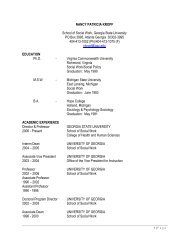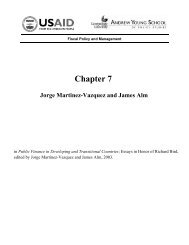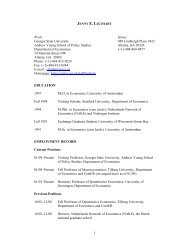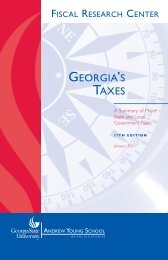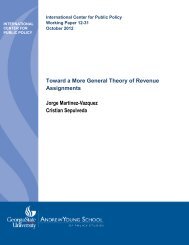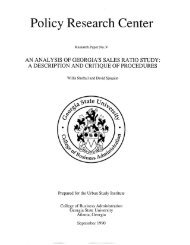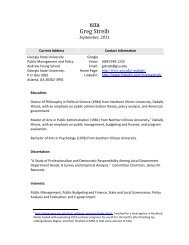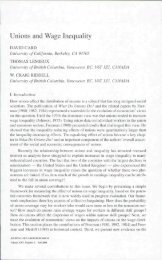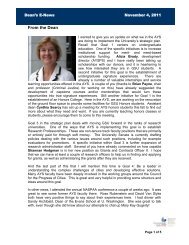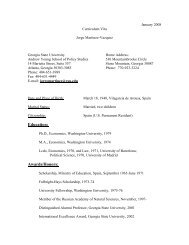Robin Boadway and Frank Flatters - Andrew Young School of Policy ...
Robin Boadway and Frank Flatters - Andrew Young School of Policy ...
Robin Boadway and Frank Flatters - Andrew Young School of Policy ...
You also want an ePaper? Increase the reach of your titles
YUMPU automatically turns print PDFs into web optimized ePapers that Google loves.
620 / <strong>Robin</strong> <strong>Boadway</strong> <strong>and</strong> <strong>Frank</strong> <strong>Flatters</strong><br />
Even if (V1' + V2') > 0 at the equilibrium, this condition might still hold if m'(L2) <<br />
0; that is, if per capita migration costs rise with the number <strong>of</strong> migrants (sufficiently<br />
rapidly). This is a reasonable assumption, since it is consistent with the notion that<br />
migrants have differing degrees <strong>of</strong> attachment to their home province. Figure 2<br />
illustrates this case. The allocation L? is the historically-given initial allocation <strong>of</strong><br />
labour over provinces while Lm is the after-migration equilibrium (which is stable).<br />
The introduction <strong>of</strong> migration costs has precluded complete depopulation. However,<br />
it is also important to observe that Lm is not in any sense an efficient allocation <strong>of</strong><br />
labour. On the contrary, as the diagram indicates, the residents <strong>of</strong> both regions may<br />
well be ultimately worse <strong>of</strong>f as a result <strong>of</strong> migration.<br />
More complicated analyses would look at the development over time <strong>of</strong> the<br />
federation as the total population grows. We shall not pursue that topic here. Rather,<br />
we shall indicate another source <strong>of</strong> inefficiency that has been prominent in the<br />
literature. Let us revert to the stable internal solution case with free migration. In this<br />
case an equilibrium such as Le in figure 1 is achieved where equal per capita utilities<br />
are obtained in the two provinces. Even in this stable case it is unlikely that the<br />
distribution Le is optimal. The most important reason for this non-optimality has to do<br />
with the inefficiency <strong>of</strong> the migration process itself. Owing to a type <strong>of</strong> migration<br />
externality, the private signals that potential migrants are getting differ from the<br />
social signals they should be receiving.16<br />
Inefficiency <strong>of</strong> migration<br />
Consider the migration equilibrium Le in figure 1. We can obtain an expresssion for<br />
the net benefit to the existing residents <strong>of</strong> a province from having one more resident.<br />
For example, in province 1 this would be (using equation (4) <strong>and</strong> the definition <strong>of</strong> X):<br />
L1VI'(L1) = ux(fl'(L1) - f(L1)/L1 + (1 - a)G1/L1)<br />
= ux((1 - a)G1/L1 - R1/L),<br />
where R1 = fi(L) - Llf'(L1) is the total rent in province 1, assuming wage rates to be<br />
equal to marginal products. Dividing through by ux we obtain the benefit to existing<br />
residents <strong>of</strong> an additional migrant in terms <strong>of</strong> consumption <strong>of</strong> X, denoted MBL1,<br />
MBL1 = (1 - a)G1 /L1 - R1/L. (9)<br />
A similar expression holds for province 2.<br />
This may be interpreted as the total amount <strong>of</strong> X residents <strong>of</strong> 1 would be willing to<br />
give up to have an additional migrant, given that the migrant were to receive his per<br />
capita share <strong>of</strong> rents. MBL, consists <strong>of</strong> two parts. The first, (1 - a)G1/L1, is the per<br />
capita tax payment less congestion cost for each resident in province 1 <strong>and</strong> will be<br />
called the fiscal externality. An additional resident consumes the public good G at an<br />
16 Another reason why free migration is non-optimal is that a social welfare optimum in a federal<br />
model, even with identical individuals, typically requires that utilities be unequal for otherwise<br />
identical individuals. This is clearly inconsistent with free migration models. The phenomenon<br />
was first pointed out by Mirrlees (1972), <strong>and</strong> is discussed in the context <strong>of</strong> local public goods<br />
by Hartwick (1980).



